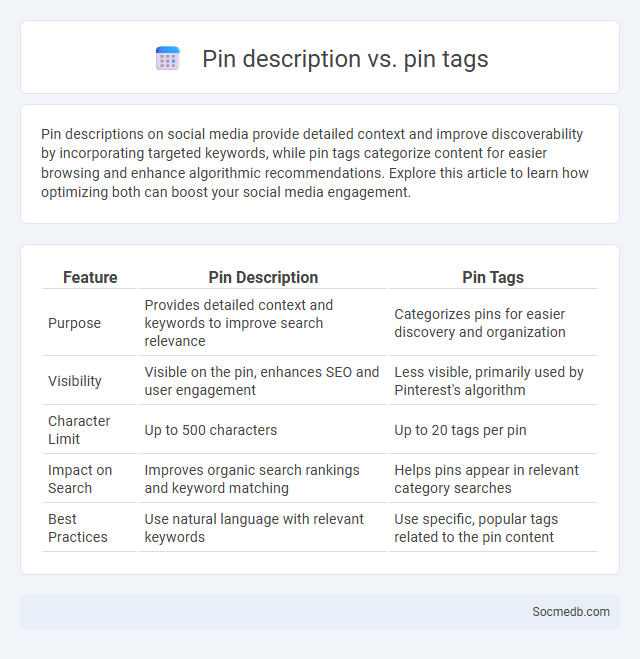
Photo illustration: pin description vs pin tags
Pin descriptions on social media provide detailed context and improve discoverability by incorporating targeted keywords, while pin tags categorize content for easier browsing and enhance algorithmic recommendations. Explore this article to learn how optimizing both can boost your social media engagement.
Table of Comparison
| Feature | Pin Description | Pin Tags |
|---|---|---|
| Purpose | Provides detailed context and keywords to improve search relevance | Categorizes pins for easier discovery and organization |
| Visibility | Visible on the pin, enhances SEO and user engagement | Less visible, primarily used by Pinterest's algorithm |
| Character Limit | Up to 500 characters | Up to 20 tags per pin |
| Impact on Search | Improves organic search rankings and keyword matching | Helps pins appear in relevant category searches |
| Best Practices | Use natural language with relevant keywords | Use specific, popular tags related to the pin content |
Understanding Pinterest: Pin Description vs. Pin Tags
Understanding Pinterest's structure enhances your content's discoverability by optimizing both Pin Descriptions and Pin Tags. Pin Descriptions provide context and improve search relevance using targeted keywords, while Pin Tags categorize your content, helping Pinterest algorithms connect your Pins with relevant audiences. Balancing descriptive language with precise tagging maximizes engagement and drives traffic effectively.
What Is a Pinterest Pin Description?
A Pinterest pin description is a brief, keyword-rich text that explains the content or purpose of an image or video saved on Pinterest, enhancing discoverability through search. It helps users understand the relevance of the pin and improves SEO by incorporating relevant terms related to the pin's topic, product, or idea. Crafting detailed and engaging descriptions increases the likelihood of repins and drives traffic to linked websites or blogs.
What Are Pinterest Pin Tags?
Pinterest pin tags are keywords or phrases you attach to your pins to improve their discoverability within Pinterest's search algorithm. They help categorize content, making it easier for users to find relevant pins based on their interests or search queries. By strategically using pin tags, you can enhance your content's visibility and increase engagement on your Pinterest profile.
Pin Description vs. Pin Tags: Key Differences
Pin description provides a detailed explanation that enhances content relevance and improves search engine visibility, while pin tags serve as concise keywords that categorize and organize pins for easier discovery. Effective pin descriptions incorporate rich, keyword-focused language to attract targeted audiences, whereas pin tags focus on specific terms to support Pinterest's algorithm in recommending content. Balancing optimized pin descriptions with strategic pin tags maximizes engagement and drives higher traffic through improved content indexing and searchability.
How Pin Descriptions Impact Pinterest SEO
Pin descriptions significantly impact Pinterest SEO by enhancing keyword relevance and improving search visibility within the platform. Well-crafted descriptions incorporating targeted keywords increase the likelihood of pins appearing in user search results and personalized feeds. Optimizing descriptions with clear, concise language and relevant hashtags boosts engagement rates, driving more traffic and improving overall content ranking on Pinterest.
Optimizing Pin Tags for Better Reach
Optimizing pin tags on social media platforms like Pinterest enhances your content's visibility by aligning with trending keywords and user search behavior. Utilize specific, relevant tags that reflect your pin's content to attract targeted audiences and improve engagement rates. Prioritize continuous analysis of tag performance to refine your strategy and maximize your reach effectively.
Best Practices for Writing Pin Descriptions
Writing effective pin descriptions on social media involves using clear, concise language and incorporating relevant keywords that enhance discoverability in search results. Your descriptions should provide valuable context and encourage engagement by highlighting unique features or benefits related to the content. Including a strong call to action and relevant hashtags increases visibility and drives more traffic to your pins.
Strategic Use of Pin Tags in Pinterest Marketing
Strategic use of pin tags in Pinterest marketing enhances content discoverability by aligning pins with targeted keywords and trending topics, driving higher engagement rates. Effective tag selection boosts SEO within the platform, increasing the likelihood of pins appearing in relevant searches and related feeds. Consistent implementation of relevant pin tags supports brand visibility and audience growth across niche markets.
Common Mistakes: Pin Description and Tag Confusion
Many users often confuse pin descriptions with tags on social media platforms, leading to poor content discoverability. Your pin description should be a clear, keyword-rich sentence that explains the content, while tags are specific keywords used for categorization and search optimization. Avoid misusing tags as descriptions, as this can reduce engagement and limit your reach.
Combining Pin Descriptions and Tags for Maximum Engagement
Combining detailed pin descriptions with relevant tags enhances content discoverability on platforms like Pinterest by aligning search intent with user interests. Optimized descriptions include targeted keywords that match trending topics, while strategically chosen tags expand reach within niche communities and improve algorithmic ranking. This synergy drives higher engagement rates, increases follower growth, and boosts overall visibility across social media networks.
 socmedb.com
socmedb.com